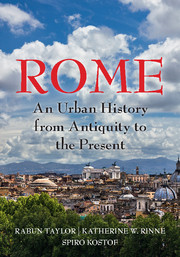Book contents
- Frontmatter
- Dedication
- Epigraph
- Contents
- List of Illustrations
- Acknowledgments
- Map
- INTRODUCTION
- 1 A BEND IN THE RIVER
- 2 A STORYBOOK BEGINNING
- 3 IDEOLOGICAL CROSSFIRE
- 4 BIG MEN ON THE CAMPUS
- 5 RES PUBLICA RESTITUTA
- 6 MEMORIALS IN MOTION: SPECTACLE IN THE CITY
- 7 THE CONCRETE STYLE
- 8 REMAKING ROME'S PUBLIC CORE: I
- 9 REMAKING ROME'S PUBLIC CORE: II
- 10 CRISIS AND CONTINUITY
- 11 RUS IN URBE: A GARDEN CITY
- 12 ADMINISTRATION, INFRASTRUCTURE, AND DISPOSAL OF THE DEAD
- 13 MAPPING, ZONING, AND SEQUESTRATION
- 14 TETRARCHIC AND CONSTANTINIAN ROME
- 15 TROPHIES AND TITULI: CHRISTIAN INFRASTRUCTURE BEFORE CONSTANTINE
- 16 WALLS MAKE CHRISTIANS: FROM FOURTH TO FIFTH CENTURY
- 17 A TALE OF TWO ROMES
- 18 THE ROME OF GOTHS AND BYZANTINES
- 19 CHRISTIAN FOUNDATIONS
- 20 FROM DOMUS LATERANI TO ROMANUM PALATIUM
- 21 THE LEONINE CITY: ST. PETER'S AND THE BORGO
- 22 VIA PAPALIS, THE CHRISTIAN DECUMANUS
- 23 THE URBAN THEATERS OF IMPERIUM AND SPQR
- 24 HOUSING DAILY LIFE
- 25 CHAOS IN THE FORTIFIED CITY
- 26 THE TIBER RIVER
- 27 HUMANIST ROME, ABSOLUTIST ROME (1420–1527)
- 28 PLANNING COUNTER REFORMATION ROME
- 29 PROCESSIONS AND POPULATIONS
- 30 MAGNIFICENT PALACES AND RHETORICAL CHURCHES
- 31 NEOCLASSICAL ROME
- 32 PICTURING ROME
- 33 REVOLUTION AND RISORGIMENTO
- 34 ITALIAN NATIONALISM AND ROMANITÀ
- 35 A CITY TURNED INSIDE OUT
- Glossary of Persons, Places, and Terms
- Works Cited
- Index
27 - HUMANIST ROME, ABSOLUTIST ROME (1420–1527)
Published online by Cambridge University Press: 05 July 2016
- Frontmatter
- Dedication
- Epigraph
- Contents
- List of Illustrations
- Acknowledgments
- Map
- INTRODUCTION
- 1 A BEND IN THE RIVER
- 2 A STORYBOOK BEGINNING
- 3 IDEOLOGICAL CROSSFIRE
- 4 BIG MEN ON THE CAMPUS
- 5 RES PUBLICA RESTITUTA
- 6 MEMORIALS IN MOTION: SPECTACLE IN THE CITY
- 7 THE CONCRETE STYLE
- 8 REMAKING ROME'S PUBLIC CORE: I
- 9 REMAKING ROME'S PUBLIC CORE: II
- 10 CRISIS AND CONTINUITY
- 11 RUS IN URBE: A GARDEN CITY
- 12 ADMINISTRATION, INFRASTRUCTURE, AND DISPOSAL OF THE DEAD
- 13 MAPPING, ZONING, AND SEQUESTRATION
- 14 TETRARCHIC AND CONSTANTINIAN ROME
- 15 TROPHIES AND TITULI: CHRISTIAN INFRASTRUCTURE BEFORE CONSTANTINE
- 16 WALLS MAKE CHRISTIANS: FROM FOURTH TO FIFTH CENTURY
- 17 A TALE OF TWO ROMES
- 18 THE ROME OF GOTHS AND BYZANTINES
- 19 CHRISTIAN FOUNDATIONS
- 20 FROM DOMUS LATERANI TO ROMANUM PALATIUM
- 21 THE LEONINE CITY: ST. PETER'S AND THE BORGO
- 22 VIA PAPALIS, THE CHRISTIAN DECUMANUS
- 23 THE URBAN THEATERS OF IMPERIUM AND SPQR
- 24 HOUSING DAILY LIFE
- 25 CHAOS IN THE FORTIFIED CITY
- 26 THE TIBER RIVER
- 27 HUMANIST ROME, ABSOLUTIST ROME (1420–1527)
- 28 PLANNING COUNTER REFORMATION ROME
- 29 PROCESSIONS AND POPULATIONS
- 30 MAGNIFICENT PALACES AND RHETORICAL CHURCHES
- 31 NEOCLASSICAL ROME
- 32 PICTURING ROME
- 33 REVOLUTION AND RISORGIMENTO
- 34 ITALIAN NATIONALISM AND ROMANITÀ
- 35 A CITY TURNED INSIDE OUT
- Glossary of Persons, Places, and Terms
- Works Cited
- Index
Summary
A WHOLLY NEW CHAPTER IN ROME'S HISTORY BEGAN WHEN THE ROMAN cardinal Oddo Colonna ascended to the pontificate in November 1417 at the Council of Constance, Switzerland. Taking the name Martin V, he chose to return the Church to its rightful home – an act that concluded the Western Schism. Negotiating safe passage through central Italy and reaching an accord with Queen Joanna of Naples to evacuate her troops from Rome delayed his entry until September 1420. When he arrived at Petrarch's “broken city,” he found Rome's 17,000 inhabitants famished and living among abandoned and teetering houses, collapsed churches and monuments, and streets buried under trash. Martin found a city desperate for rehabilitation.
Cardinals and curial officers, hangers-on, eager opportunists, merchants, and prostitutes followed in his wake, swelling the population to nearly 30,000 within a few years. Although Martin left little personal stamp on Rome, he prepared the city for a Jubilee in 1423. He made strategic repairs to Ponte Sant'Angelo, to the church and palace at SS. Apostoli (the old Basilica Apostolorum, a Colonna property), and to the Lateran basilica – the last a bid to reestablish papal control over the derelict Caelian Hill. Most significantly, Martin placed the office of the maestri delle strade, citizens appointed by the Senate and charged with maintaining urban order, under direct papal authority in 1425.
If we may speak of a single moment in Rome's urban history when the Middle Ages decidedly gave way to the Renaissance, it would be the ascension of Nicholas V Parentucelli (1447–1455) from Liguria in northwest Italy. He used urban restoration as a political tool to repair the image of papal primacy and to wrest control from the Comune, which had thrived during the Avignon papacy. Nicholas ushered in a nearly 90-year run of non-Roman popes who brought with them foreign cardinals and foreign bankers. Unlike pontiffs and nobles of the previous 800 years, who had adapted existing buildings and streets to meet changing conditions, these men were unburdened by sentimental ties to the city. They laid down new streets, ransacked neighborhoods, and imposed their own urban logic on what they saw as the chaotic medieval city, particularly in anticipation of Jubilee years.
- Type
- Chapter
- Information
- RomeAn Urban History from Antiquity to the Present, pp. 251 - 260Publisher: Cambridge University PressPrint publication year: 2016



